In this topic, we'll learn why it's good practice to cut the spent flowers off certain plants, like this petunia (Petunia × atkinsiana).
In earlier modules, we covered the majority of plant maintenance tasks, from growing from seed and transplanting, to harvesting and pruning, to protecting plants from pests and diseases and invasive weeds.
In this topic, we pick up a few loose ends, specifically two different types of pruning and how to train plants.
Deadheading
Deadheading is the practice of removing spent or faded flowers from plants, usually ornamental plants. It involves cutting off the flower heads, removing them by pinching, or snapping them off. Deadheading is performed on flowering plants, particularly those that produce multiple blooms over a season, such as:
- roses
- petunias
- marigolds
- delphiniums
- echinaceas.
Deadheading is important because it:
- Tidies up the plants: Deadheading helps maintain the overall appearance and attractiveness of the plant and the garden as a whole. Removing faded flowers keeps the plant looking neat and tidy, preventing the garden from becoming cluttered with wilted or unattractive blooms.
- Encourages continued blooming: By removing spent flowers, deadheading stimulates the plant to produce new blooms. Many flowering plants have a natural instinct to produce seeds once their flowers fade. By removing the spent flowers, you prevent seed formation and redirect the plant's energy towards producing more flowers. This can extend the blooming period and result in a more abundant display of flowers.
- Prevents seed production and self-sowing: Deadheading prevents plants from expending energy on seed production. This is especially beneficial if you want to prevent self-sowing or if you have limited space in your garden. Some plants can self-sow prolifically, leading to overcrowding or invasive behaviour. By deadheading, you reduce the chances of unwanted seedlings taking over the garden.
- Redirects nutrients: Removing spent flowers allows the plant to redirect its resources towards other important activities, such as root development, foliage growth, or storing energy for the next season. It promotes overall plant health and vigour.
- Controls disease and pests: Deadheading can help prevent the spread of diseases and discourage pests. Faded flowers are more susceptible to fungal diseases and can attract pests. Removing them promptly reduces the risk of disease and pest infestation.
In this video from Fraser Valley Rose Farm, Jason demonstrates how to deadhead roses and perennials:
Hedging (hedge trimming)
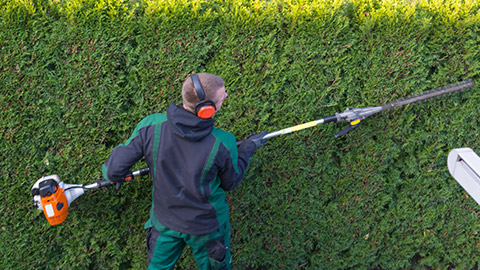
This tall hedge of emerald cedar (Thuja occidentalis) is being trimmed with a petrol-powered pole hedge trimmer.
Hedges can be grown to provide privacy, define borders, reduce noise, create windbreaks, or a combination of these. You might like to grow hedges along exposed sections of your property to break up and slow down the winds that knock your garden plants around in the spring.
Hedges can be formed by planting trees or shrubs close together and allowing them to grow to their natural size and shape. For instance, it’s fairly common to see feijoa hedges on rural properties. However, in this subtopic we are talking about the process of trimming the hedge into a defined shape and size.
Hedging tools
The most commonly used tools for trimming hedges (hedging) are:
| Tool | Description | |
|---|---|---|
| Hedge shears | These are like large scissors with long, straight blades that have either straight or wavy cutting edges. | 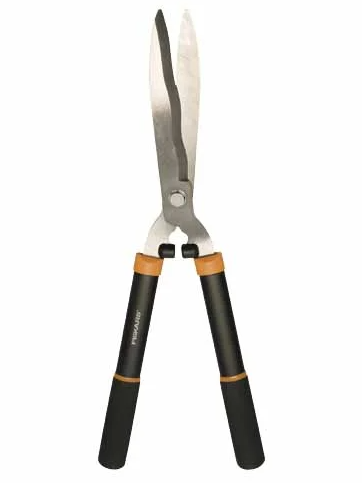 Fiskars Softgrip Wavy Blade Hedge Shears |
| Hedge trimmer | These are petrol or electric powered hand-tools that has a long, straight blade with large teeth sticking out like fingers along its length. The blade is usually made of hardened steel or a similar durable material. There are two sets of “fingers” with one or both sets moving forward and back when in operation, causing them to pass each other and cause a cutting action similar to a pair of scissors. | EGO cordless hedge trimmer skin 56 volt 65cm |
| Pole hedge trimmer | This is similar to the hedge trimmer mentioned above, except that the engine or motor is connected to the blade by a long, sometimes extendible, shaft, or pole. | Stihl HLA 135 cordless long-reach hedge trimmer |
Tractor-mounted hedge trimmer
For tall hedges or in cases where you have a lot of hedgerows – such as an orchard – the best option is usually to hire a hedge trimming contractor. These usually have a boom with several large cutting discs attached. The operator can adjust the height and angle of the boom to position the cutters where they need to be and then use the machine’s own motion – forward, backyard and steering – to move along the hedge.
This mesmerising video from Glenn shows one of these machines in action in a vineyard in Hawke’s Bay.
Planning for and trimming a hedge
There are five key considerations when maintaining a trimmed hedge:
- Choose species that are suitable for hedging. These can range from small to large but must be able to tolerate hedging. Examples include:
Small Box (Buxus sempervirens) 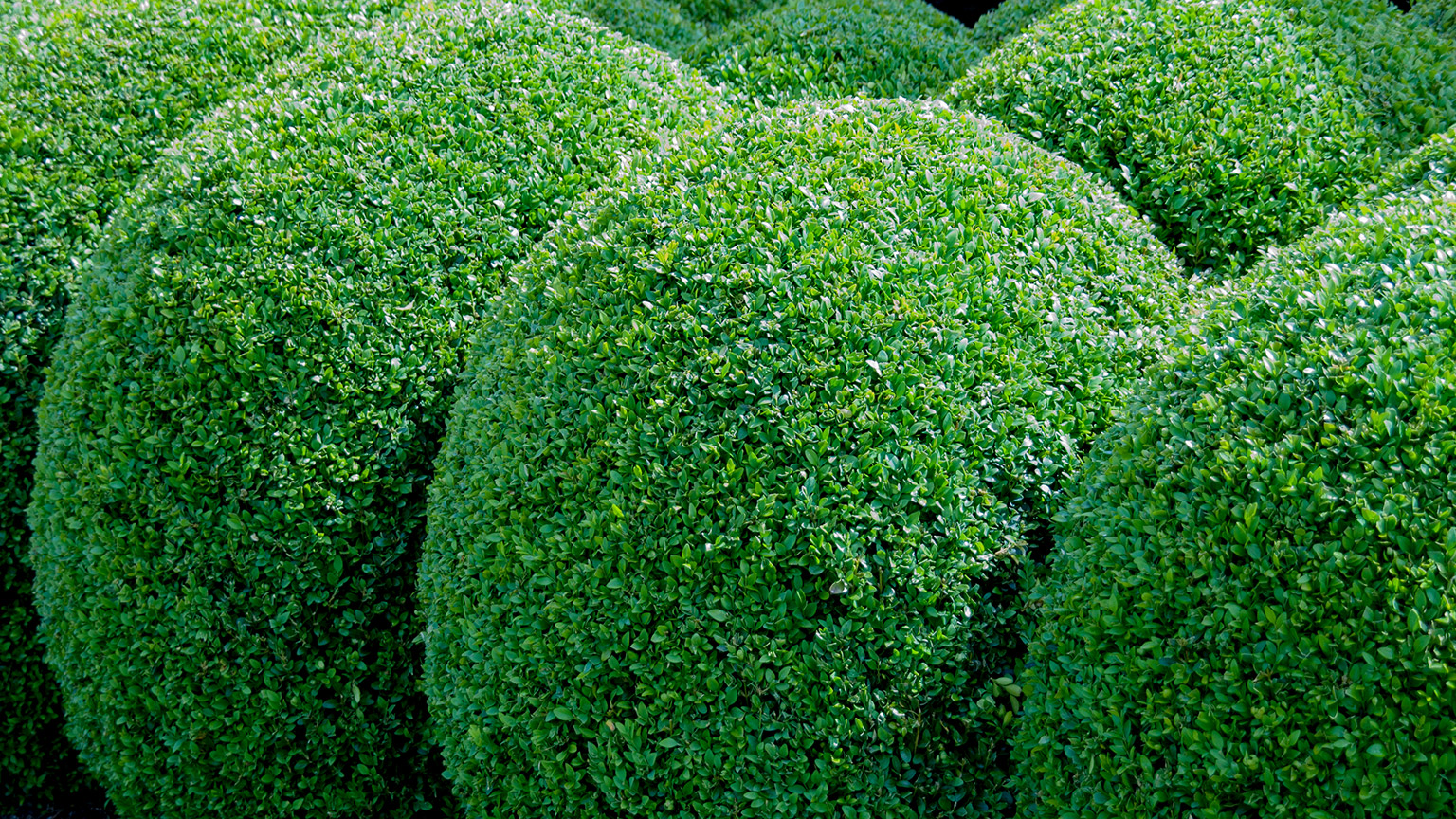
Medium Camellia (Camellia spp.) and kohuhu (Pittosporum tenufolium)


Large Thuja plicata 'Green Giant' 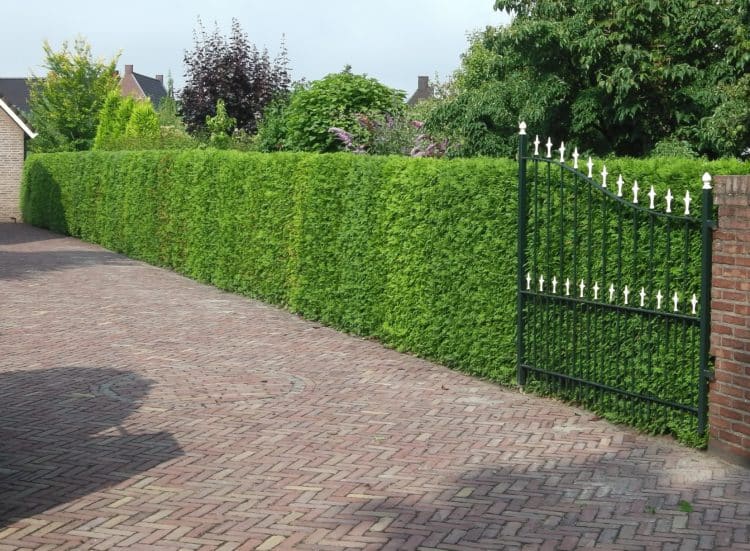
Tall and thin She-oak (Casuarina spp.) and Monterey pine (Pinus radiata) [not pictured.] 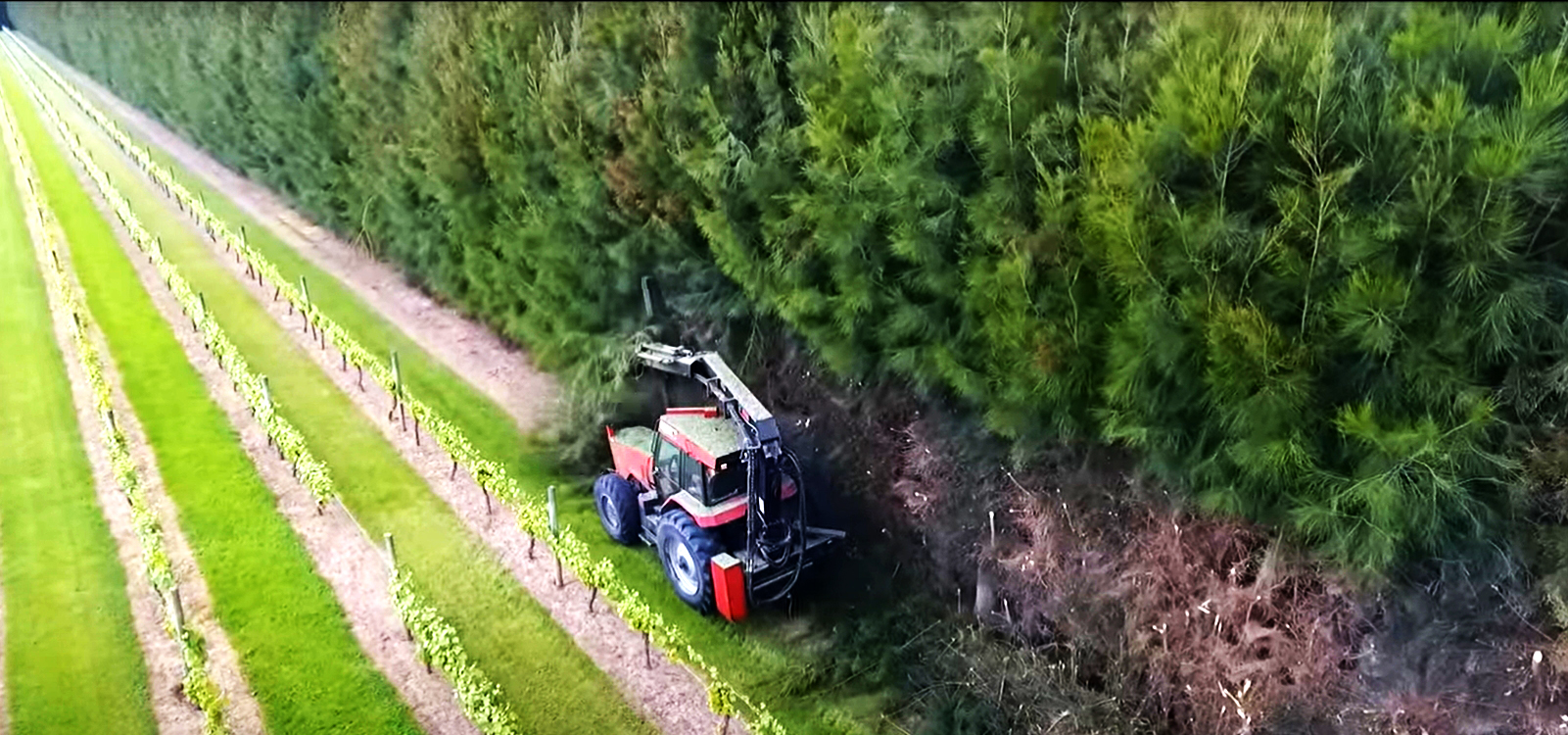
Screenshot from the video above. The hedge is She-oak. - Decide how large you want the hedge to grow, both in terms of height and width, ensuring that this is smaller than the mature size of the species you have chosen.
- Start hedging your plants back when they are about 80% of your intended size.
- So if you want a hedge that is 1m wide, when it reaches 80cm wide, hedge it in slightly; perhaps 5cm on each side. This will help encourage the branches to send out new shoots and leaves.
- Repeat the process when it reaches 90% then let it get to full size and continue to hedge it back to the same width.
- When trimming the hedge, gently rest the trimmer on the foliage, don’t dig too far in or you will expose bare spots. This video by Polo Fields Lawn Service shows how to trim shrubs using a hedging technique:
Practice makes perfect, so starting to trim your hedges before they reach your desired size means that if you make a mistake, the plants can regrow around any errors.
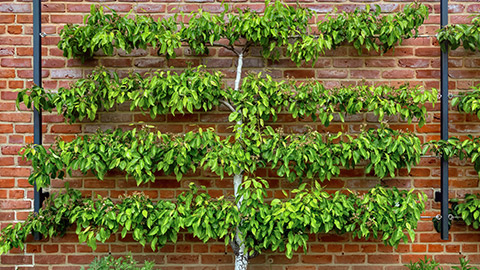
This apple tree has been trained in a style called espalier.
Training plants means encouraging them to grow in a particular direction, by bending and pruning parts of the plant.
| The most extreme version of this is probably the ancient Japanese art of bonsai, but there are more functional reasons for training plants too. | 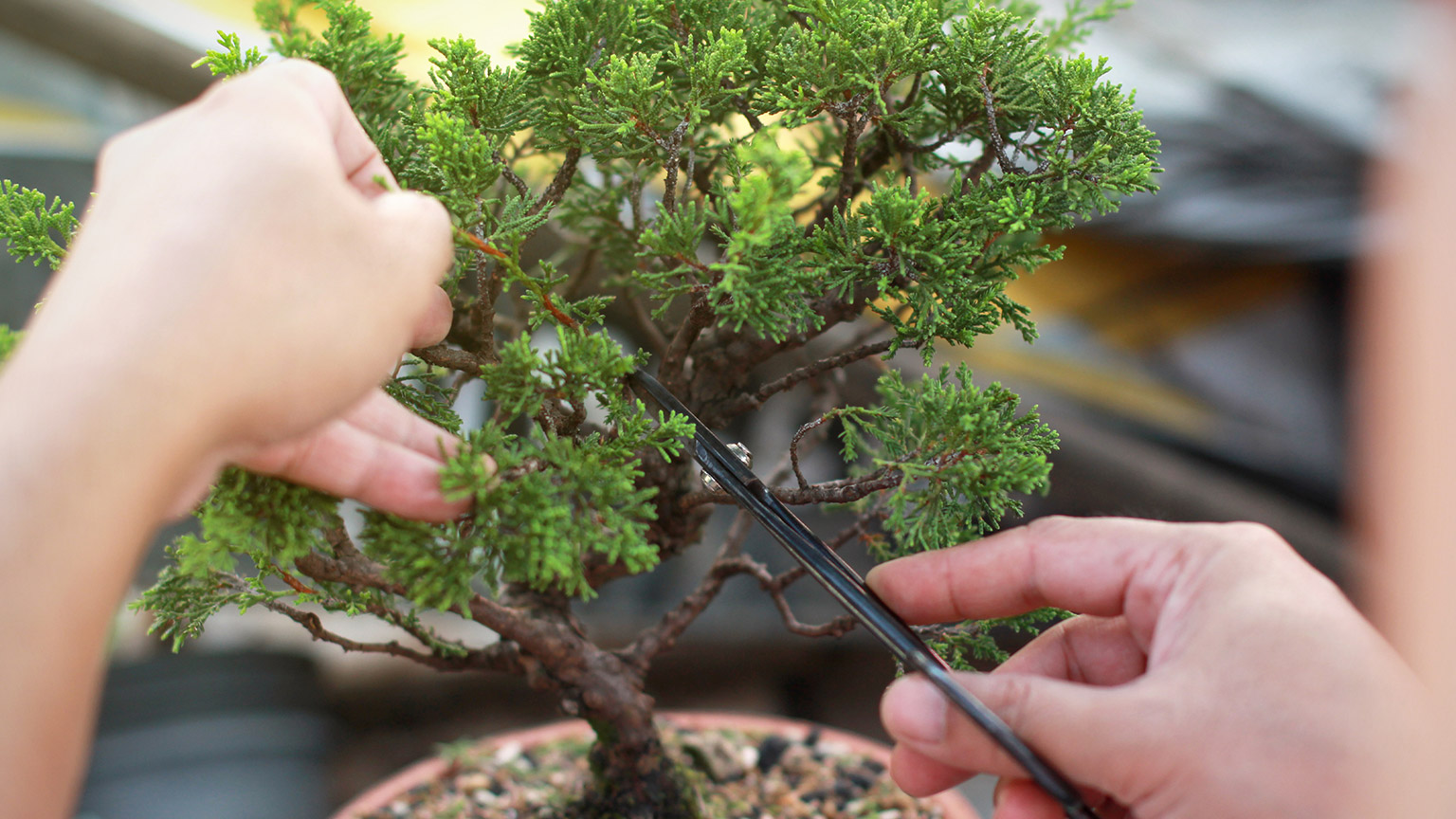 |
The Solaxe method
In Module 2 we learned about the central leader and vase shape tree forms most commonly used for fruit trees.
Take a moment and refresh your memory with this activity.
One variation of the central leader shape is called the Solaxe method. This was developed in France and is sometimes referred to as the French central leader method.
In this approach, branches are not headed back to encourage vigour. Instead, the tree is pruned to have a central leader and a number of large branches which are trained to grow downwards. These large branches are called scaffold branches. The aim is to create a tree that, at maturity, puts most of its energy into fruit rather than new branches.
The following video by HORTGRO gives a good overview of the process of pruning and training trees using the Solaxe method:
Training should take place in spring or at the end of summer while the branches still have sap flowing through them and are flexible. Pruning should take place in the winter.
▶ The Permaculture Orchard: Beyond Organic (optional)
The following section provides an excellent description of this process.
| Topic | From – To |
|---|---|
| Training and pruning | 1:30:10 – 1:43:00 |
If you didn't purchase the optional video, watch the following videos instead. They cover the same information although not as succinctly.
Training: Watch this video by Edible Backyard, How to train a new fruit tree.
Pruning: Watch the video called The Quick & Dirty.
Remember, the key actions for the Solaxe method are:
- Training:
- Bend scaffolding branches down below horizontal when they are about 1m long and leave in that position for at least two months.
- When the tree reaches your desired height, bend the tip down below horizontal as per scaffolding branches.
- Pruning:
- Clear the chimney - no small branches growing off the trunk or off the scaffolding branches within about 150mm of the trunk.
- Cut back the number of scaffolding branches to 12-15. If you have more than 15, remove branches that are:
- Low to the ground
- Big – have a diameter of more than half of the trunk diameter
- Line – forms a line from the trunk directly into the aisle/pathway or directly towards a tree next to it.
Supporting vines
Many vines, such as tomatoes, cucumbers, peas, and grapes need support. Let’s look at a few ways we can provide the support they need.
Trellising
This video from Growfully with Jenna shows a simple way to indeterminate tomatoes using metal “cow panel” trellis. It also provides useful tips on how to prune the tomatoes to allow light and air movement to reduce the chance of diseases:
Stringing vines
An alternative to using a trellis is to use string, which the plants can attach to and climb up. This video from Berkeley Farm shows this process in action.
Watch the video from 3:00-5:00 to see how stringing works. Keep watching if you’re interested in how to prune cucumbers.
Growing vines up other plants
The “Three Sisters” planting approach originated in central Mexico and involves growing corn (Zea mays), beans (Phaseolus vulgaris), and squash (Cucurbita spp.) as companion plants. In this approach, the bean grows up the stalks of the corn, and all three plants benefit one another.
This video by GRIN-U Education (10:53), provides an excellent summary of the approach and its history:
Dedicated structures
Some vine crops, such as grapes and kiwifruit are grown commercially on dedicated structures. On a smaller scale, you might find that growing them along wires to form an espalier is a good solution.
If you’re intending on growing either of these at a commercial scale, research the different support systems, including talking to other growers, before committing to one.
Espalier
Espalier is a plant training technique that involves bending and pruning trees or shrubs to grow flat against a wall, trellis, or framework in a specific pattern. The word "espalier" originates from the French term "épaler," meaning "to spread out."
In this video by GrowOrganic Peaceful Valley (3:49), Patricia Boudier shows how to train trees into an espalier design: How to Grow an Espalier
The key steps are:
- Selecting a suitable plant species, such as an apple, pear, or peach.
- Forming a framework of supports to tie the tree to. The support should be sturdy enough to hold the weight of the trained branches and allow for attachment or tying of the branches. If you plan to grow your plant in front of a solid wall or fence, make sure your framework and tree are at least 150mm away from the wall.
- Planting the tree, in line with the support structure.
- Pruning and training the tree to shape.
- Untying branches when they have “set” in their position to ensure that they don’t become damaged by growing around the ties.
Activities – Helping plants thrive
Answer these four questions to help you feel confident you understood when and why we prune and train plants. Be sure to check the solution if you don't get them all correct.
Some plants require a bit of extra support to stay upright. Think about the physical characteristics of a plant that may impact this need before you move on to this activity.
There are times when support isn't provided to keep the plant upright rather, it is provided to train the plant into a desirable shape. The following activity requires you to consider the process of growing plants into an espelier design.
